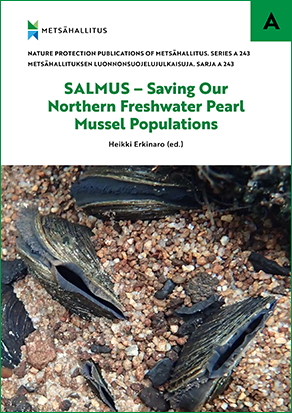SALMUS – Saving Our Northern Freshwater Pearl Mussel Populations
Freshwater pearl mussel (Margaritifera margaritifera) (FPM) is a critically endangered taxon (CR) in Europe. The species is dependent on juvenile salmonid fish as larval hosts and has also highquality criteria for stream habitat conditions. Main factors preventing successful recruitment of FPM are lack of suitable host fish and siltation of river bottoms due to adverse land-use practices in the river catchments.
The SALMUS project was implemented in 2019–2022 by eight organizations from four countries with the aim to increase biological knowledge base and to develop conservation methods in the Green Belt of Fennoscandia (GBF). Also, the harmonization of status assessment of rivers, by using FPM and salmonid fish as indicators of ecosystem health, was a common goal in joint river systems. Awareness-raising of northern river ecosystems and their socio-economic importance was also a central theme in the project.
Searching for new FPM occurrences, performed by aquascoping and diving in 360 separate waterbodies, resulted in 14 new populations. Viability status of local FPM populations was assessed in 45 streams with 16 populations reaching the two highest viability classes. However, most studied FPM populations do not reproduce in a sustainable manner. Conservation actions would be needed to reach a favourable status: restoration in the river channels and abandonment of adverse land-use practices in the catchment areas.
In the SALMUS project, captive breeding was used as a first-aid recovery method for FPM populations in the large Tuloma River system where Atlantic salmon has not been available as a host fish for the main river FPM populations since the 1960s due to river harnessing. Transplantation of mussel juveniles back to their home river after living for one year attached in the gills of their host fish resulted in successful recruitment.
Development and cross-border harmonization of ecological monitoring methods were also key goals of the project. Novel methods assessing physical condition of FPM individuals and measuring oxygen conditions in the stream bottoms were tested in the project. Both methods, accompanied with an in-stream restoration approach, were also adopted in permanent use of participating organizations.
Values and other perceptions on northern river ecosystems were explored with an ecosystem service survey. The results showed that non-monetary services and values were strongly recognized as beneficial across all stakeholder groups and people largely supported more resourcing and effective management practices to safeguard the wellbeing of river ecosystems.
